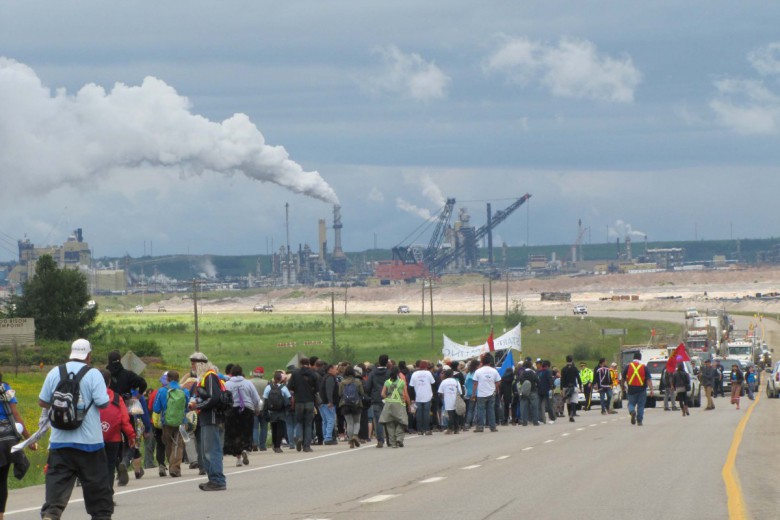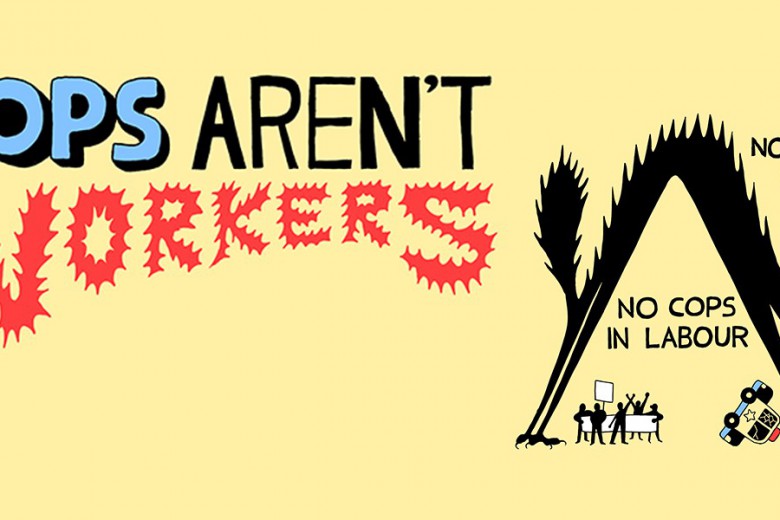
Since coming to power, the Harper Conservatives have moved aggressively to expand Canada’s Foreign Worker Program, making it increasingly easy for employers to import workers from abroad. In this first segment of our special report on Canada’s invisible workforce, Karl Flecker investigates the impact on workplace rights in Canada, and how the labour movement is responding.Though they are still largely invisible on the political scene, their impact on the Canadian labour market has been pronounced. They are guest workers, sometimes called temporary workers or migrant workers, or assigned the more alien and marginalizing label foreign workers—which is how the federal government officially refers to them.
In 2006, there were 171,844 temporary foreign workers living in Canada—a 122 per cent increase over a decade ago—and there’s every indication that the program will continue to grow. As the Canadian workforce ages and birth rates decline, this new cohort of economic migrants is fast becoming a potent source of wealth, and their labour is increasingly propping up our standard of living.
In the 2007 budget, the Conservative government declared its intention “to create the best educated, most skilled, and most flexible workforce in the world” (emphasis added). Migrant workers are the keystone of their efforts to create this “flexible” workforce. But who stands to benefit from this policy, and who will pay the price?
Top 10 Source Countries for Canadian Temporary Foreign Workers (2006):
1. United States 15.0%
2. Mexico 12.4%
3. France 7.7%
4. Philippines 7.6%
5. Australia 6.6%
6. United Kingdom 6.4%
7. Jamaica 5.6%
8. Japan 5.0%
9. Germany 3.6%
10. India 3.4%
Source: Canadian government figures
Workers on demand
The Foreign Worker Program has a number of components, including the Live-in Caregiver Program, the Seasonal Agricultural Worker Program, a pilot project for occupations requiring lower levels of formal training, and oil sands construction projects in Alberta.
In all cases the Foreign Worker Program enables Canadian employers to import workers from other countries when employers claim there is a labour shortage within Canada to fill their jobs.
Since coming to power in early 2006, the Harper government has made significant changes to the program, making it much easier for employers to access workers from abroad. Early in the Conservatives’ tenure, then Immigration Minister Monte Solberg made it clear that if employers needed labour in particular regions of the country, he was happy to accommodate them by fast-tracking the Foreign Worker Program. This past November, Solberg quipped, “It doesn’t matter whether you’re in Camrose or Calgary, Edson or Edmonton, ‘Help Wanted’ signs are everywhere. When it starts to affect our ability to go to Tim Hortons and get a double-double, it ceases to be a laughing matter.”
Under the Conservatives, many changes have been made to the Foreign Worker Program and virtually all are focused on serving employers’ demand for migrant workers as quickly as possible. For example, the Conservatives have established lists of occupations and sectors that qualify for fast tracking permits to import migrant labour, created a step-by-step guide in “employer-friendly language” on how to hire a foreign worker, and assigned government staff “to assist employers seeking to hire foreign workers in cases where a labour market opinion is not required.” The 2007 budget provided for an additional $50.5 million over two years to “reduce processing delays and more effectively respond to regional labour and skill shortages.”
Under the recent changes, employers no longer have to advertise for Canadian workers for a minimum of six weeks—now they need only advertise for seven days before seeking a permit to hire workers from abroad.
Other “administrative efficiencies” include opening new offices in B.C. and Alberta to assist employers in fast-tracking their applications for temporary workers.
Though reliance on guest workers is a growing phenomenon across the country, the effects of these changes have been particularly pronounced in turbocharged Alberta. During the fiscal year ending March 31, 2007, approximately 31,000 applications for temporary foreign workers were processed in the province—with an additional 9,000 outstanding—compared to a total of 12,000 during the previous year. Significantly, the number of temporary workers has now, for the first time ever, eclipsed the number of permanent immigrants who gained entry into the province.
Abuse and misuse of guest workers
What has not been a priority for the government, however, is to build into the Foreign Worker Program effective compliance, monitoring and enforcement mechanisms that will ensure that Canadian employers respect the rights of the guest workers they invite into the country, as well as the rights of any Canadian workers they may displace.
Even before this program was enhanced to favour employers’ needs, human rights groups, the labour movement, immigrant settlement agencies, community-based migrant worker advocates, and faith groups had been pointing out flaws in the program. These groups have been witness to how guest workers are fleeced by unscrupulous labour brokers who charge exorbitant “processing fees” in exchange for work permits; how workers are misled with false promises about wages and working conditions; how they are exploited, intimidated and threatened with deportation by some employers unless they accept terms akin to indentured servitude; how they are faced with social isolation and separation from their families and communities; and, additionally, how they are sometimes exposed to sickening doses of racism and discrimination from the communities in which they work.
The incidents are both grave and numerous. For example, in September 2006, Park Place Seniors Living Ltd. laid off some 70 long-serving unionized care aides in Kelowna, B.C. who were earning a wage of just over $20 per hour. The private seniors’ care facility then hired a private labour contractor, AdvoCare, to provide care services for the 149 residents of the facility. AdvoCare posted the positions at $14 to $15 per hour, and when the former employees refused to accept the reduced wage rate, AdvoCare cited a “labour shortage” in its application to hire migrant workers under the government’s Foreign Worker Program. In addition to reduced wages, AdvoCare offered a significantly reduced benefits package, eliminating sick leave, long-term disability, paid vacation and pension benefits previously held by the care aides.
Despite this labour injustice, the government granted the contractor the permits they requested. According to the government’s own criteria for the management of the Foreign Worker Program, if a labour dispute is ongoing or imminent, the granting body must consider this factor and could refuse the application on those grounds. That the presence of a labour dispute is merely a factor to be considered and not cause for automatic rejection of the application is a perfect illustration of whose interests are truly represented through these programs.
Subsequently, in late November 2006, as the union representing the dismissed workers, the B.C. Government and Service Employees’ Union (BCGEU/NUPGE), was in the process of applying for union certification for the new care aides at the Kelowna seniors’ facility, AdvoCare submitted a second application to hire yet more migrant workers. Until the union wrote a detailed letter to the government department responsible for the program, neither federal nor regional Human Resources and Social Development Canada (HRSDC) departments had consulted with the union about AdvoCare’s permit applications. This neglect was yet another contravention of the program’s criteria.
In another case, the B.C. & Yukon Territory Building & Construction Trades Council (BCYT-BCTC) recently discovered that the centuries-old racist practice of using exploited workers from overseas to build major infrastructure projects like Canada’s transcontinental railline was being repeated today.
A Canadian-Italian consortium involving SNC Lavalin corporation and an Italian company called SELI Tecnologie is collaborating in the construction of twin tunnels for a rapid-transit line in downtown Vancouver known as the RAV line. The consortium had brought in temporary construction workers from Costa Rica, Columbia and Peru. Patrick Johnson, a union member of the Operating Engineers Local 115, struck up a conversation with some of the workers and learned they were working 11 hours a day, six days a week on the RAV line project and that for most, their hourly wage was less than $5 per hour with no overtime bonus. If Canadian unionized workers had been hired, the prevailing wage range would have been between $25 and $30 an hour plus overtime.
Johnson passed on what he learned from the temporary construction workers to the BCTC, which sent its researcher, Joe Barrett, to learn more about the migrant workers’ situation. Subsequently, the BCTC organized a press conference to expose the exploitative and racist scandal.
When the story went public, “all hell broke loose,” says Barrett. “The workers were told [by the company] not to talk to reporters. Then they were handed contracts in English only, and told to sign them immediately. It was intimidating.”
BCTC has helped organize these workers to receive a just wage for their labour, and they have succeeded in getting the B.C. Employment Standards Branch to investigate the wage issues. They have also demanded a full public inquiry into the Temporary Foreign Worker Program.
Hazardous workplaces
Participants in the Foreign Worker Program face not only economic exploitation, but also a heightened risk of injury or death. In northern Alberta in late April of this year, 27-year-old Chinese scaffolder Liuhongliang and 33-year-old electrical engineer Ge Genbao were both killed when the roof of the massive oil container they were working on collapsed. Four others were injured. They had been working for a Chinese company contracted by Canadian Natural Resources for work on its Horizon tar sands project. The company plans to bring 500 more migrant workers in on the program. A second tank collapsed on May 12, leading the Alberta Federation of Labour to call for the immediate shutdown of the work site.
Questions persist about why these two workers died and a dozen others were injured. Were there adequate workplace safeguards in place? Were workplace hazards made clear and fully understood? Officials from the province’s occupational health and safety department are conducting their own investigation.
Meanwhile, on the day after the second tank’s collapse, a young Thai agricultural worker died in Chatham, Ontario, at the home where he and other migrant agricultural workers resided. He was the second Thai worker to die in the house this year. Community members wonder if both these deaths might be related to exposure to biocides used in the agricultural industry.
What role for the labour movement?
As the Foreign Worker Program has grown, so too have complaints from workers. In 2007, in an effort to provide these workers with an advocate, the Alberta Federation of Labour initiated a project to address their issues. Under the Advocate Project, the AFL hired a lawyer to assist this group of vulnerable workers with free legal support to address their many grievances. The persistent failure of the federal and provincial governments to put in place effective compliance, monitoring and enforcement mechanisms left the field wide open for such a service.
The AFL initially intended the program to be a part-time support service for a one-year period. Shortly after the Advocate Project began, however, the lawyer began receiving over 50 calls a week from desperate migrant workers looking for assistance, and has been taking on more than 10 new cases each week.
Individual unions have also stepped up to challenge the numerous policy flaws of the government programs, such as the inequitable path to citizenship rights or the absence of language training and community integration.
United Food & Commercial Workers Local 1118, for instance, represents 4,000 workers at a hog plant in Red Deer, Alberta. Olymel, the company that operates the plant, is Canada’s largest pork and poultry processor, with plants in Québec and Ontario, as well as Red Deer.
In early 2007, Olymel demanded significant wage concessions from their workers in Québec. When the workers rejected the concession plans, which would have cost each worker about $12,000 per year in lost wages and benefits, Olymel dumped over 500 workers. Jobs were relocated from other plants to the Red Deer plant, which has received permits to bring in some 400 guest workers from the Dominican Republic, Guatemala, the Philippines and the Ukraine.
When the union was informed that Olymel would be bringing in temporary workers, Albert Johnson, president of the union local, responded by saying, “before that could happen certain conditions would have to be put in place.” Recognizing that workers protected by citizenship rights are less easily exploited or intimidated, Local 1118 negotiated collective agreement language and memorandums of understanding that support migrant workers who want to apply for permanent-resident status. When the first 240 migrant workers arrived, the UFCW was able to get 190 registered into the Alberta Provincial Nominee Program. Today about 75 have already received their citizenship papers.
In addition, the union negotiated with Olymel to fund a workplace training and community integration program. This innovative project has created six new paid trainer positions, which have been filled by workers from the shop floor. The trainers provide ESL and workplace safety training for the migrant workers, and are tasked with helping to integrate the guest workers into the workplace and the community. Their job begins with picking up the migrant workers at the airport, helping settle them into their accommodation, and providing workplace and community integration training.
The workers’ camaraderie and banter on the workplace floor is an invaluable support that helps the migrant workers improve their ESL skills. Gains they make in language learning are included in their citizenship assessment process.
Using the collective agreement process in this way has helped to bring union members and migrant workers together in a unique solidarity project, which ironically began when workers in Québec paid a price by losing their jobs for refusing massive wage and benefit concessions in Olymel’s plants in Québec.
The Migrant Justice Network
Canada’s rapidly expanding Foreign Worker Program is having a dramatic impact on workplaces and communities across the country. What was once a small program with pockets of migrant agricultural workers and live-in caregivers has now spread to the health-care, transportation, service, hospitality, construction and tourism sectors.
Because there is so much potential for exploitation and abuse of the program, labour, faith groups, (im)migrant rights groups, and immigration and settlement agencies have begun joining together in an alliance to address this new terrain. Collectively dubbed the Migrant Justice Network, these interests have come together to share their experiences and advocate for equitable workplace rules and a welcoming community ethos that protects the rights of all workers, despite the government’s efforts to advance a policy framework that is ripe for abuse.
Karl Flecker is the national director of the anti-racism and human rights department of the Canadian Labour Congress.






